Silence Speaks Confidence
Why composure is the first signal people notice in you
Think about the last time you sat in a meeting and someone rushed through their point. The words spilled out quickly, every pause filled with “um” or “you know,” and before you had time to digest one idea, the next one was already on its way.
It wasn’t the content that made them sound unsteady—it was the delivery. What was missing was composure.
Composure is the first of the four signals people notice when assessing confidence. And it shows up most clearly in your ability to pause.
A pause is not wasted time. It’s what gives your words weight. The silence between sentences is where your message lands. Stillness often conveys confidence more powerfully than words themselves. You’re signaling that you trust your idea enough to let it breathe.
I often say, “Pause equals poise.” People who seem most at ease in a room aren’t those who speak the fastest or loudest. They’re the ones who can hold space without rushing to fill it.
Early in my career, I thought speed equaled competence. I babbled, afraid that if I paused, someone else would jump in and I’d lose my chance. A mentor once told me, “If your point matters, it can stand on its own.” That changed how I approached communication. When I began practicing pauses—replacing filler words with silence—people didn’t cut me off. They leaned in.
Why does this happen? Because composure signals control. When you pause, you show that nerves aren’t controlling you. You’re setting the pace, and in doing so, you calm not just yourself but also the room.
The composer Claude Debussy put it best: “Music is the space between the notes.” Communication is the same. Without pauses, speech is noise—continuous, unbroken, overwhelming. With pauses, it gains rhythm, texture, and impact.
This matters even more in technical communication. Engineers and analysts often want to share everything they’ve discovered. However, information delivered without pauses can get lost. A pause gives the audience space to process complexity. It turns a data dump into a dialogue.
Building the Skill of Pausing
In daily conversations, replace a filler word with silence.
Notice that the silence feels longer to you than to others.
Listen fully before replying; permit yourself a pause.
Rehearse intentional pauses in your presentations, before and after key points.
Think of pauses not as gaps, but as invitations for others to lean in.
Composure isn’t about freezing or stripping emotion away. It’s about being anchored. Silence feels risky at first, but once you see how it shifts the room, it becomes your advantage.
For technical experts, composure is transformative. Your work is judged not just on accuracy but on how confidently you present it. Composure makes even complex ideas feel grounded and approachable. It says: I believe in this enough to let it breathe.
Reflection Prompts
❶ How do I usually respond to silence in conversations? By filling it, or by allowing it to be filled?
❷ Where can I replace a filler word with a pause in my daily interactions?
❸ How might pausing more change the way people perceive my confidence?
Composure is the first of the four signals of calm confidence. It begins with something simple: the courage to pause. In the following article, we’ll explore the second signal—attention—how your eyes reveal presence before you speak a single word.


